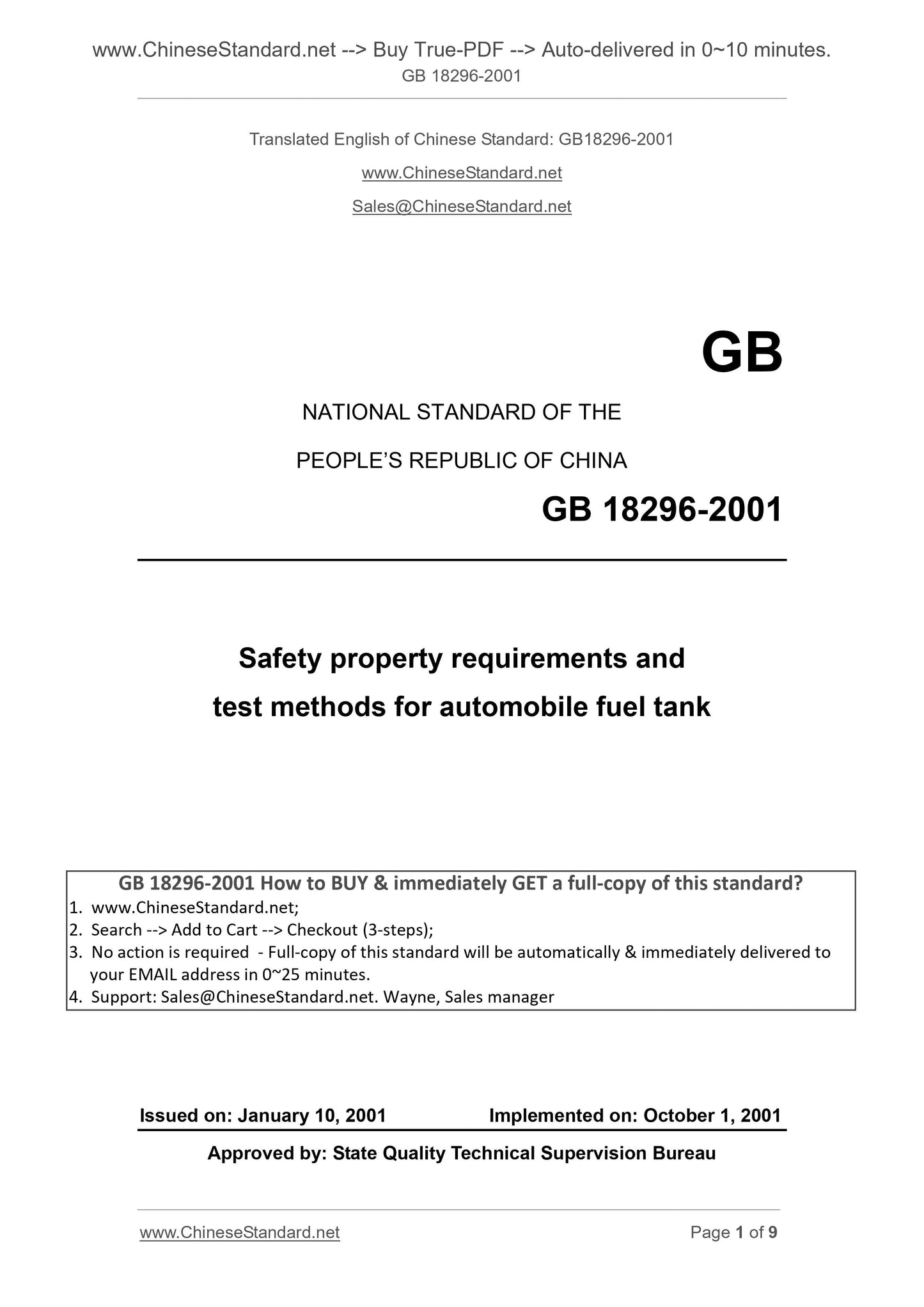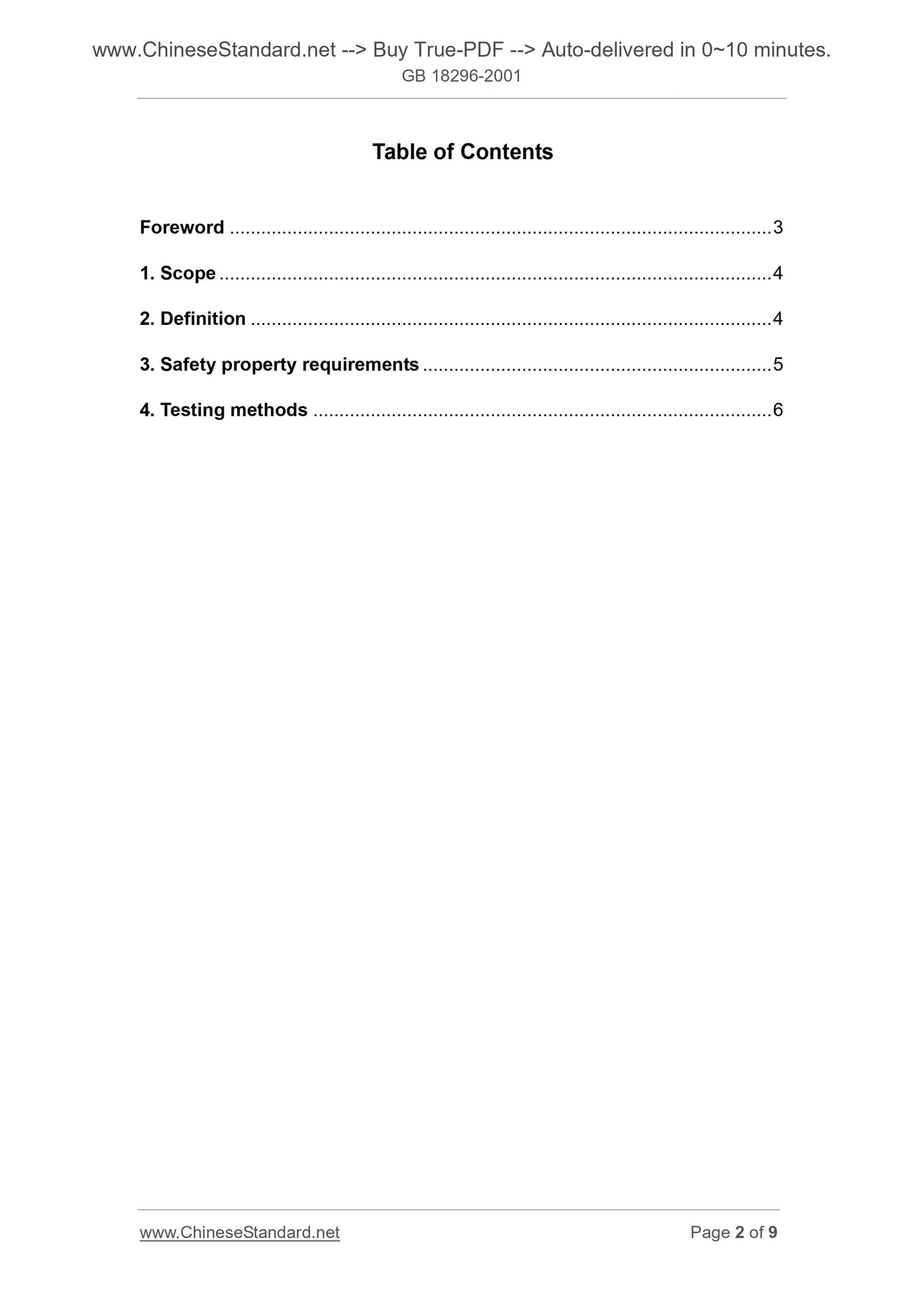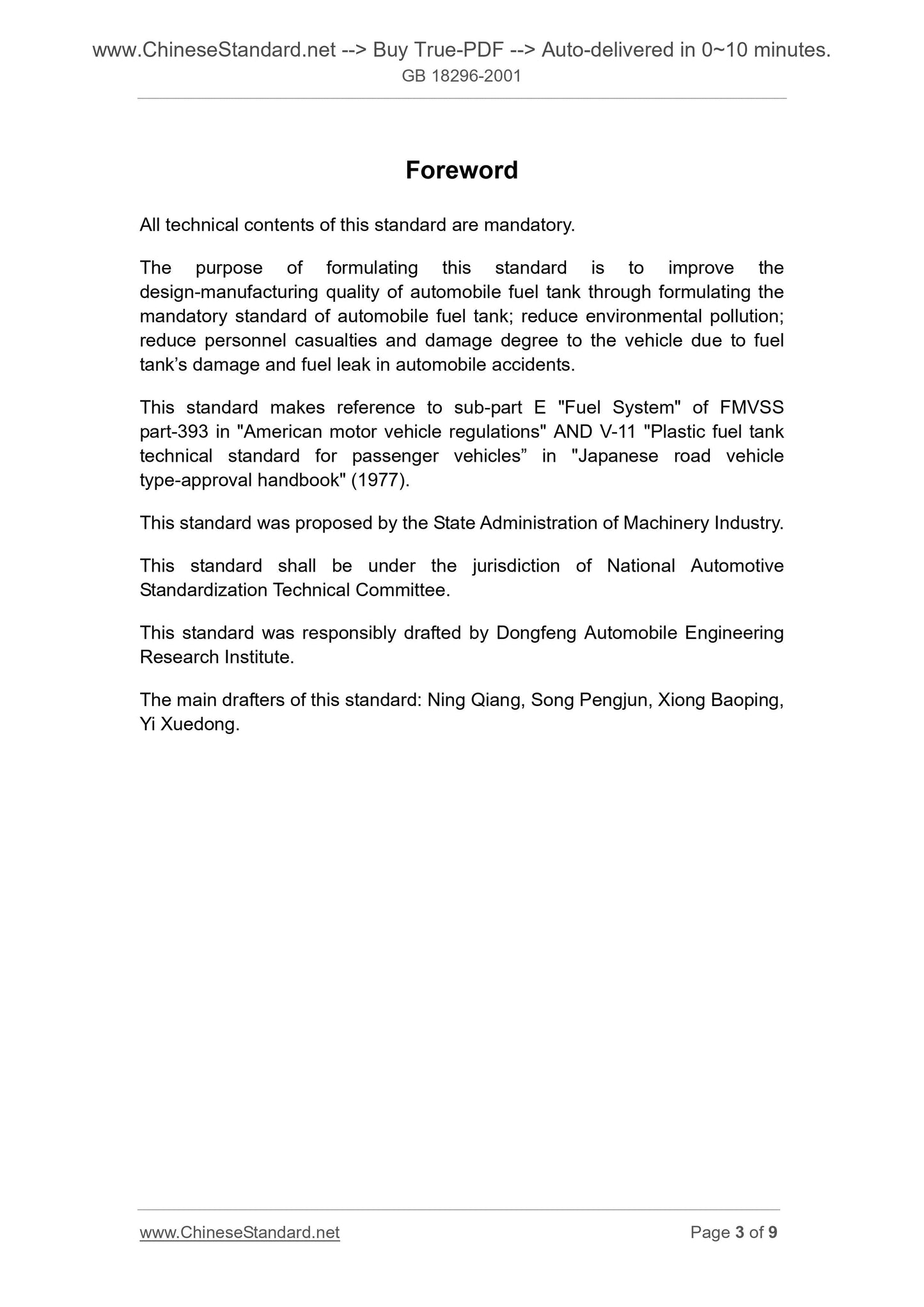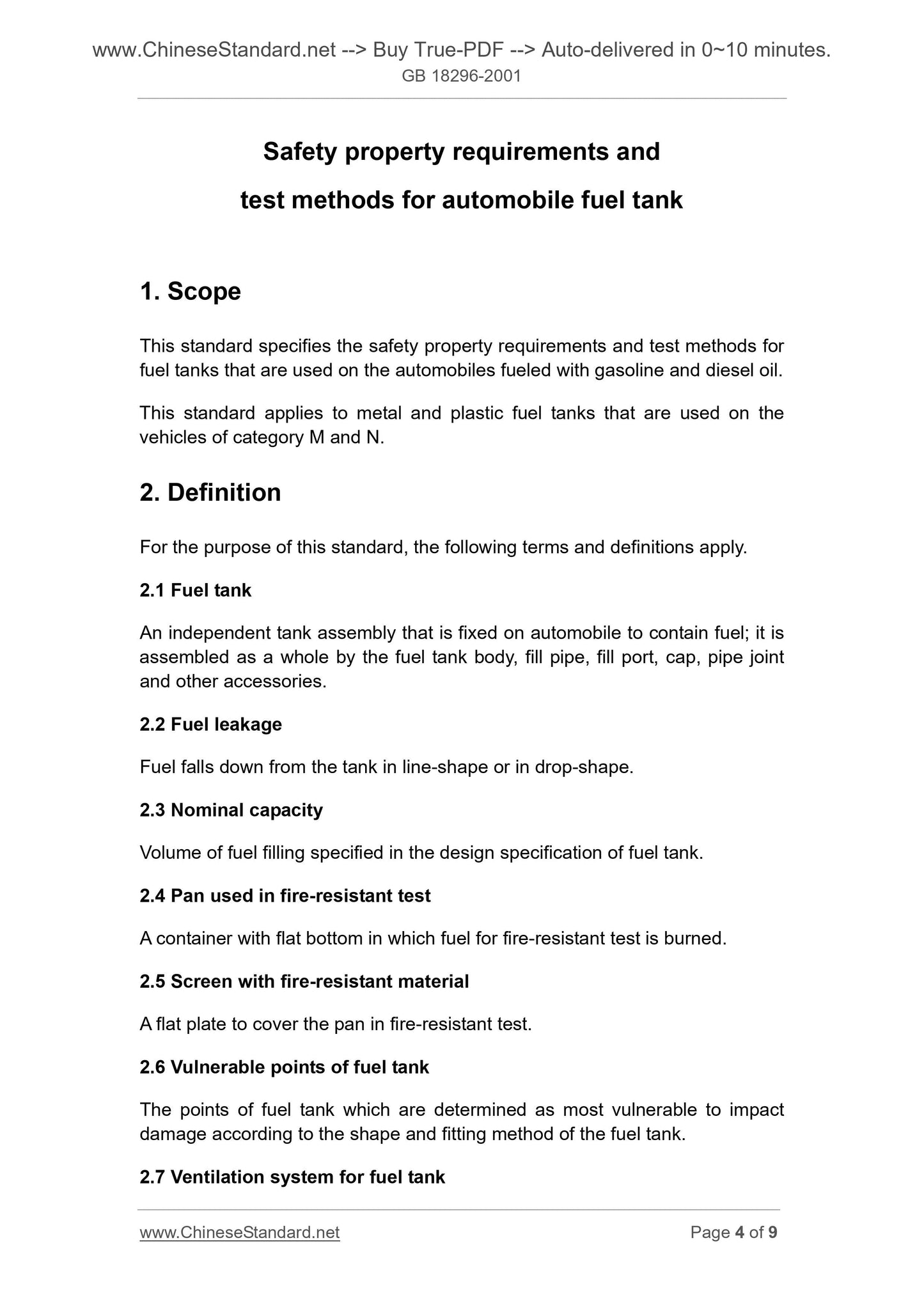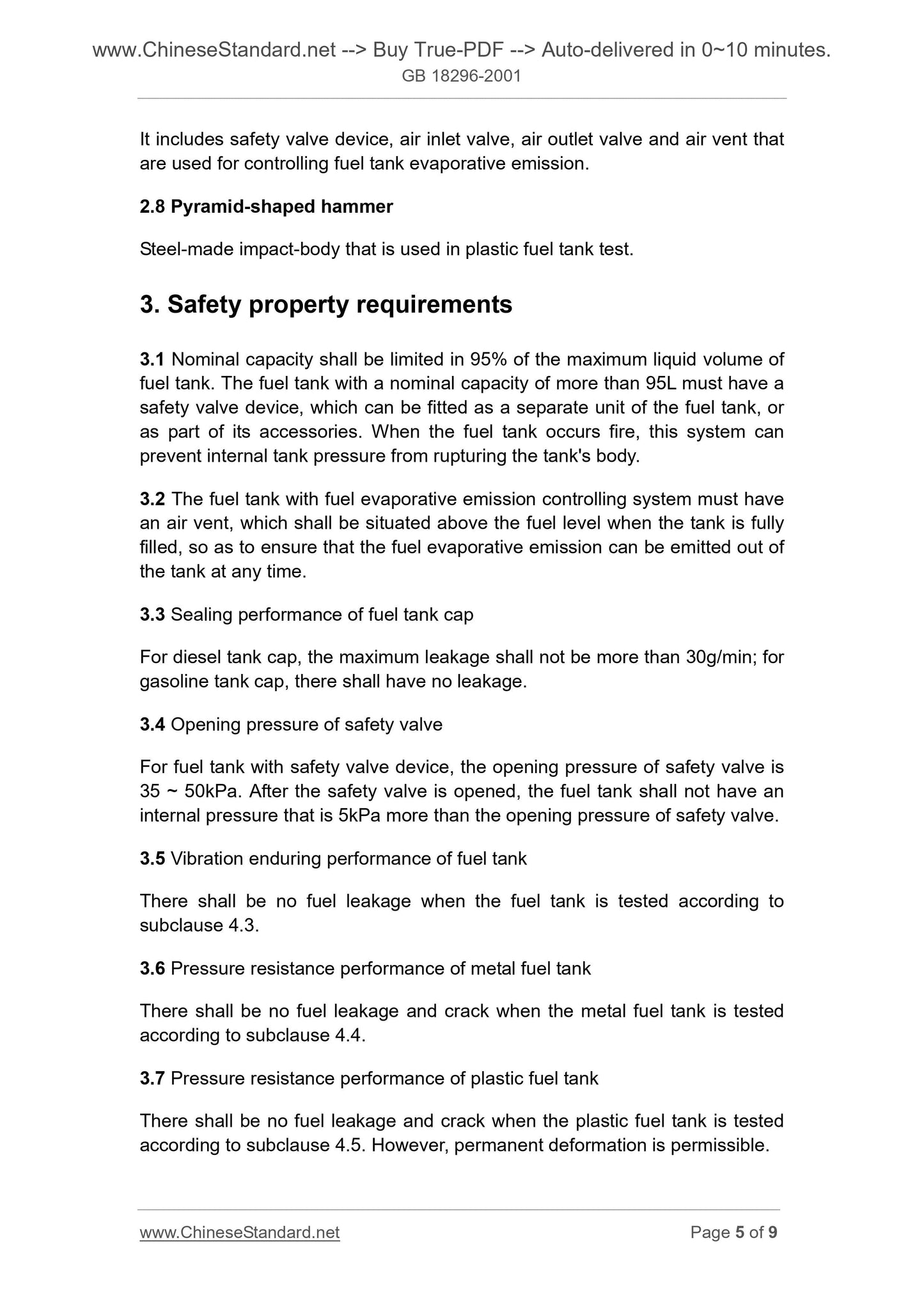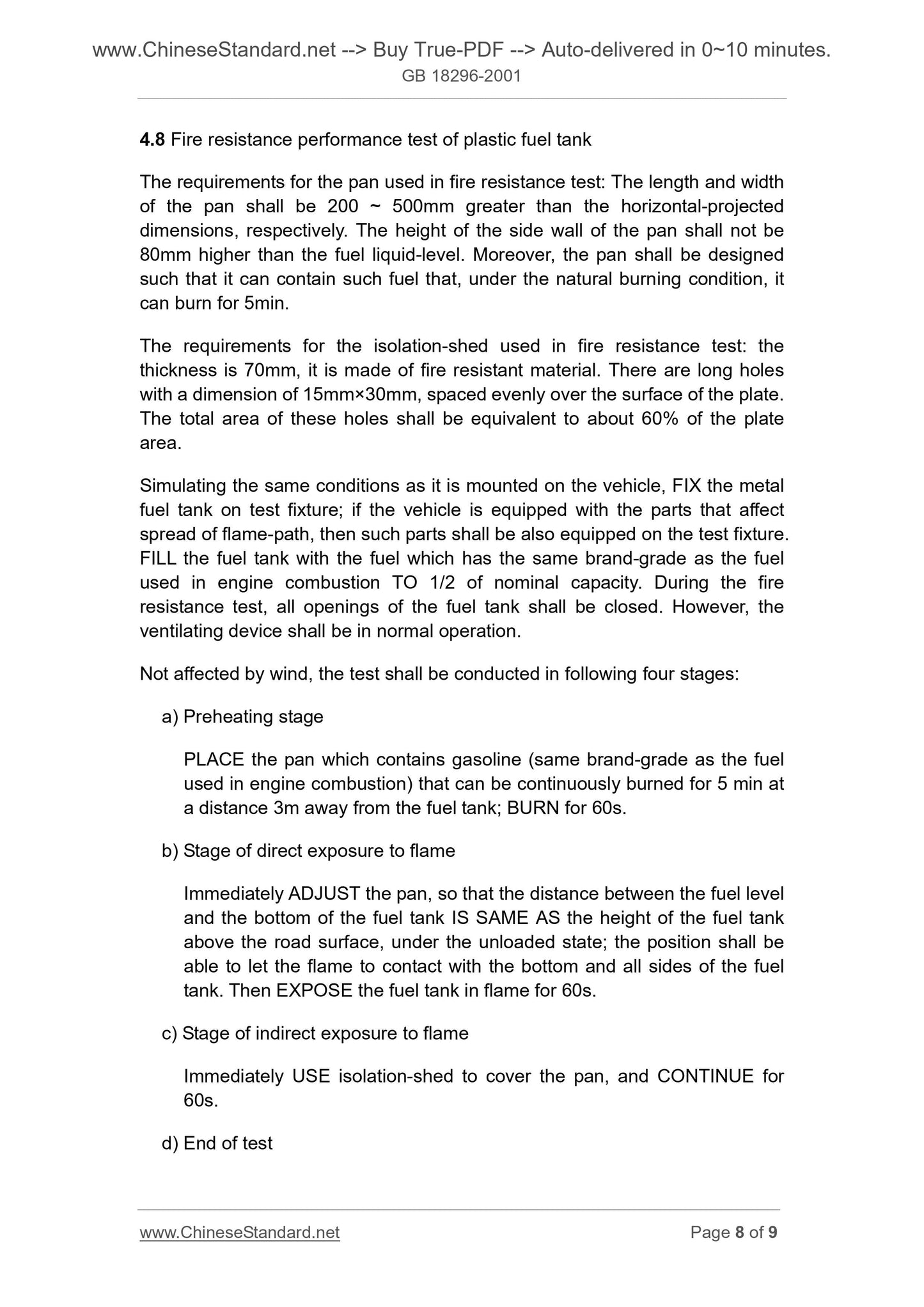1
/
of
6
PayPal, credit cards. Download editable-PDF & invoice in 1 second!
GB 18296-2001 English PDF (GB18296-2001)
GB 18296-2001 English PDF (GB18296-2001)
Regular price
$70.00 USD
Regular price
Sale price
$70.00 USD
Unit price
/
per
Shipping calculated at checkout.
Couldn't load pickup availability
Delivery: 3 seconds. Download true-PDF + Invoice.Newer version: (Replacing this standard) GB 18296-2019
Get QUOTATION in 1-minute: Click GB 18296-2001
Historical versions: GB 18296-2001
Preview True-PDF (Reload/Scroll if blank)
GB 18296-2001: Safety property requirements and test methods for automobile fuel tank
GB 18296-2001
GB
NATIONAL STANDARD OF THE
PEOPLE’S REPUBLIC OF CHINA
Safety property requirements and
test methods for automobile fuel tank
ISSUED ON. JANUARY 10, 2001
IMPLEMENTED ON. OCTOBER 1, 2001
Approved by. State Quality Technical Supervision Bureau
Table of Contents
Foreword ... 3
1. Scope ... 4
2. Definition ... 4
3. Safety property requirements ... 5
4. Testing methods ... 6
Foreword
All technical contents of this standard are mandatory.
The purpose of formulating this standard is to improve the
design-manufacturing quality of automobile fuel tank through formulating the
mandatory standard of automobile fuel tank; reduce environmental pollution;
reduce personnel casualties and damage degree to the vehicle due to fuel
tank’s damage and fuel leak in automobile accidents.
This standard makes reference to sub-part E "Fuel System" of FMVSS
part-393 in "American motor vehicle regulations" AND V-11 "Plastic fuel tank
technical standard for passenger vehicles” in "Japanese road vehicle
type-approval handbook" (1977).
This standard was proposed by the State Administration of Machinery Industry.
This standard shall be under the jurisdiction of National Automotive
Standardization Technical Committee.
This standard was responsibly drafted by Dongfeng Automobile Engineering
Research Institute.
The main drafters of this standard. Ning Qiang, Song Pengjun, Xiong Baoping,
Yi Xuedong.
Safety property requirements and
test methods for automobile fuel tank
1. Scope
This standard specifies the safety property requirements and test methods for
fuel tanks that are used on the automobiles fueled with gasoline and diesel oil.
This standard applies to metal and plastic fuel tanks that are used on the
vehicles of category M and N.
2. Definition
For the purpose of this standard, the following terms and definitions apply.
2.1 Fuel tank
An independent tank assembly that is fixed on automobile to contain fuel; it is
assembled as a whole by the fuel tank body, fill pipe, fill port, cap, pipe joint
and other accessories.
2.2 Fuel leakage
Fuel falls down from the tank in line-shape or in drop-shape.
2.3 Nominal capacity
Volume of fuel filling specified in the design specification of fuel tank.
2.4 Pan used in fire-resistant test
A container with flat bottom in which fuel for fire-resistant test is burned.
2.5 Screen with fire-resistant material
A flat plate to cover the pan in fire-resistant test.
2.6 Vulnerable points of fuel tank
The points of fuel tank which are determined as most vulnerable to impact
damage according to the shape and fitting method of the fuel tank.
2.7 Ventilation system for fuel tank
It includes safety valve device, air inlet valve, air outlet valve and air vent that
are used for controlling fuel tank evaporative emission.
2.8 Pyramid-shaped hammer
Steel-made impact-body that is used in plastic fuel tank test.
3. Safety property requirements
3.1 Nominal capacity shall be limited in 95% of the maximum liquid volume of
fuel tank. The fuel tank with a nominal capacity of more than 95L must have a
safety valve device, which can be fitted as a separate unit of the fuel tank, or
as part of its accessories. When the fuel tank occurs fire, this system can
prevent internal tank pressure from rupturing the tank's body.
3.2 The fuel tank with fuel evaporative emission controlling system must have
an air vent, which shall be situated above the fuel level when the tank is fully
filled, so as to ensure that the fuel evaporative emission can be emitted out of
the tank at any time.
3.3 Sealing performance of fuel tank cap
For diesel tank cap, the maximum leakage shall not be more than 30g/min; for
gasoline tank cap, there shall have no leakage.
3.4 Opening pressure of safety valve
For fuel tank with safety valve device, the opening pressure of safety valve is
35 ~ 50kPa. After the safety valve is opened, the fuel tank shall not have an
internal pressure that is 5kPa more than the opening pressure of safety valve.
3.5 Vibration enduring performance of fuel tank
There shall be no fuel leakage when the fuel tank is tested according to
subclause 4.3.
3.6 Pressure resistance performance of metal fuel tank
There shall be no fuel leakage and crack when the metal fuel tank is tested
according to subclause 4.4.
3.7 Pressure resistance performance of plastic fuel tank
There shall be no fuel leakage and crack when the plastic fuel tank is tested
according to subclause 4.5. However, permanent deformation is permissible.
4.8 Fire resistance performance test of plastic fuel tank
The requirements for the pan used in fire resistance test. The length and width
of the pan shall be 200 ~ 500mm greater than the horizontal-projected
dimensions, respectively. The height of the side wall of the pan shall not be
80mm higher than the fuel liquid-level. Moreover, the pan shall be designed
such that it can contain such fuel that, under the natural burning condition, it
can burn for 5min.
The requirements for the isolation-shed used in fire resistance test. the
thickness is 70mm, it is made of fire resistant material. There are long holes
with a dimension of 15mm×30mm, spaced evenly over the surface of the plate.
The total area of these holes shall be equivalent to about 60% of the plate
area.
Simulating the same conditions as it is mounted on the vehicle, FIX the metal
fuel tank on test fixture; if the vehicle is equipped with the parts that affect
spread of flame-path, then such parts shall be also equipped on the test fixture.
FILL the fuel tank with the fuel which has the same brand-grade as the fuel
used in engine combustion TO 1/2 of nominal capacity. During the fire
resistance test, all openings of the fuel tank shall be closed. However, the
ventilating device shall be in normal operation.
Not affected by wind, the test shall be conducted in following four stages.
a) Preheating stage
PLACE the pan which contains gasoline (same brand-grade as the fuel
used in engine combustion) that can be continuously burned for 5 min at
a distance 3m away from the fuel tank; BURN for 60s.
b) Stage of direct exposure to flame
Immediately ADJUST the pan, so that the distance between the fuel level
and the bottom of the fuel tank IS SAME AS the height of the fuel tank
above the road surface, under the unloaded state; the position shall be
able to let the flame to contact with the bottom and all sides of the fuel
tank. Then EXPOSE the fuel tank in flame for 60s.
c) Stage of indirect exposure to flame
Immediately USE isolation-shed to cover the pan, and CONTINUE for
60s.
d) End of test
Get QUOTATION in 1-minute: Click GB 18296-2001
Historical versions: GB 18296-2001
Preview True-PDF (Reload/Scroll if blank)
GB 18296-2001: Safety property requirements and test methods for automobile fuel tank
GB 18296-2001
GB
NATIONAL STANDARD OF THE
PEOPLE’S REPUBLIC OF CHINA
Safety property requirements and
test methods for automobile fuel tank
ISSUED ON. JANUARY 10, 2001
IMPLEMENTED ON. OCTOBER 1, 2001
Approved by. State Quality Technical Supervision Bureau
Table of Contents
Foreword ... 3
1. Scope ... 4
2. Definition ... 4
3. Safety property requirements ... 5
4. Testing methods ... 6
Foreword
All technical contents of this standard are mandatory.
The purpose of formulating this standard is to improve the
design-manufacturing quality of automobile fuel tank through formulating the
mandatory standard of automobile fuel tank; reduce environmental pollution;
reduce personnel casualties and damage degree to the vehicle due to fuel
tank’s damage and fuel leak in automobile accidents.
This standard makes reference to sub-part E "Fuel System" of FMVSS
part-393 in "American motor vehicle regulations" AND V-11 "Plastic fuel tank
technical standard for passenger vehicles” in "Japanese road vehicle
type-approval handbook" (1977).
This standard was proposed by the State Administration of Machinery Industry.
This standard shall be under the jurisdiction of National Automotive
Standardization Technical Committee.
This standard was responsibly drafted by Dongfeng Automobile Engineering
Research Institute.
The main drafters of this standard. Ning Qiang, Song Pengjun, Xiong Baoping,
Yi Xuedong.
Safety property requirements and
test methods for automobile fuel tank
1. Scope
This standard specifies the safety property requirements and test methods for
fuel tanks that are used on the automobiles fueled with gasoline and diesel oil.
This standard applies to metal and plastic fuel tanks that are used on the
vehicles of category M and N.
2. Definition
For the purpose of this standard, the following terms and definitions apply.
2.1 Fuel tank
An independent tank assembly that is fixed on automobile to contain fuel; it is
assembled as a whole by the fuel tank body, fill pipe, fill port, cap, pipe joint
and other accessories.
2.2 Fuel leakage
Fuel falls down from the tank in line-shape or in drop-shape.
2.3 Nominal capacity
Volume of fuel filling specified in the design specification of fuel tank.
2.4 Pan used in fire-resistant test
A container with flat bottom in which fuel for fire-resistant test is burned.
2.5 Screen with fire-resistant material
A flat plate to cover the pan in fire-resistant test.
2.6 Vulnerable points of fuel tank
The points of fuel tank which are determined as most vulnerable to impact
damage according to the shape and fitting method of the fuel tank.
2.7 Ventilation system for fuel tank
It includes safety valve device, air inlet valve, air outlet valve and air vent that
are used for controlling fuel tank evaporative emission.
2.8 Pyramid-shaped hammer
Steel-made impact-body that is used in plastic fuel tank test.
3. Safety property requirements
3.1 Nominal capacity shall be limited in 95% of the maximum liquid volume of
fuel tank. The fuel tank with a nominal capacity of more than 95L must have a
safety valve device, which can be fitted as a separate unit of the fuel tank, or
as part of its accessories. When the fuel tank occurs fire, this system can
prevent internal tank pressure from rupturing the tank's body.
3.2 The fuel tank with fuel evaporative emission controlling system must have
an air vent, which shall be situated above the fuel level when the tank is fully
filled, so as to ensure that the fuel evaporative emission can be emitted out of
the tank at any time.
3.3 Sealing performance of fuel tank cap
For diesel tank cap, the maximum leakage shall not be more than 30g/min; for
gasoline tank cap, there shall have no leakage.
3.4 Opening pressure of safety valve
For fuel tank with safety valve device, the opening pressure of safety valve is
35 ~ 50kPa. After the safety valve is opened, the fuel tank shall not have an
internal pressure that is 5kPa more than the opening pressure of safety valve.
3.5 Vibration enduring performance of fuel tank
There shall be no fuel leakage when the fuel tank is tested according to
subclause 4.3.
3.6 Pressure resistance performance of metal fuel tank
There shall be no fuel leakage and crack when the metal fuel tank is tested
according to subclause 4.4.
3.7 Pressure resistance performance of plastic fuel tank
There shall be no fuel leakage and crack when the plastic fuel tank is tested
according to subclause 4.5. However, permanent deformation is permissible.
4.8 Fire resistance performance test of plastic fuel tank
The requirements for the pan used in fire resistance test. The length and width
of the pan shall be 200 ~ 500mm greater than the horizontal-projected
dimensions, respectively. The height of the side wall of the pan shall not be
80mm higher than the fuel liquid-level. Moreover, the pan shall be designed
such that it can contain such fuel that, under the natural burning condition, it
can burn for 5min.
The requirements for the isolation-shed used in fire resistance test. the
thickness is 70mm, it is made of fire resistant material. There are long holes
with a dimension of 15mm×30mm, spaced evenly over the surface of the plate.
The total area of these holes shall be equivalent to about 60% of the plate
area.
Simulating the same conditions as it is mounted on the vehicle, FIX the metal
fuel tank on test fixture; if the vehicle is equipped with the parts that affect
spread of flame-path, then such parts shall be also equipped on the test fixture.
FILL the fuel tank with the fuel which has the same brand-grade as the fuel
used in engine combustion TO 1/2 of nominal capacity. During the fire
resistance test, all openings of the fuel tank shall be closed. However, the
ventilating device shall be in normal operation.
Not affected by wind, the test shall be conducted in following four stages.
a) Preheating stage
PLACE the pan which contains gasoline (same brand-grade as the fuel
used in engine combustion) that can be continuously burned for 5 min at
a distance 3m away from the fuel tank; BURN for 60s.
b) Stage of direct exposure to flame
Immediately ADJUST the pan, so that the distance between the fuel level
and the bottom of the fuel tank IS SAME AS the height of the fuel tank
above the road surface, under the unloaded state; the position shall be
able to let the flame to contact with the bottom and all sides of the fuel
tank. Then EXPOSE the fuel tank in flame for 60s.
c) Stage of indirect exposure to flame
Immediately USE isolation-shed to cover the pan, and CONTINUE for
60s.
d) End of test
Share
